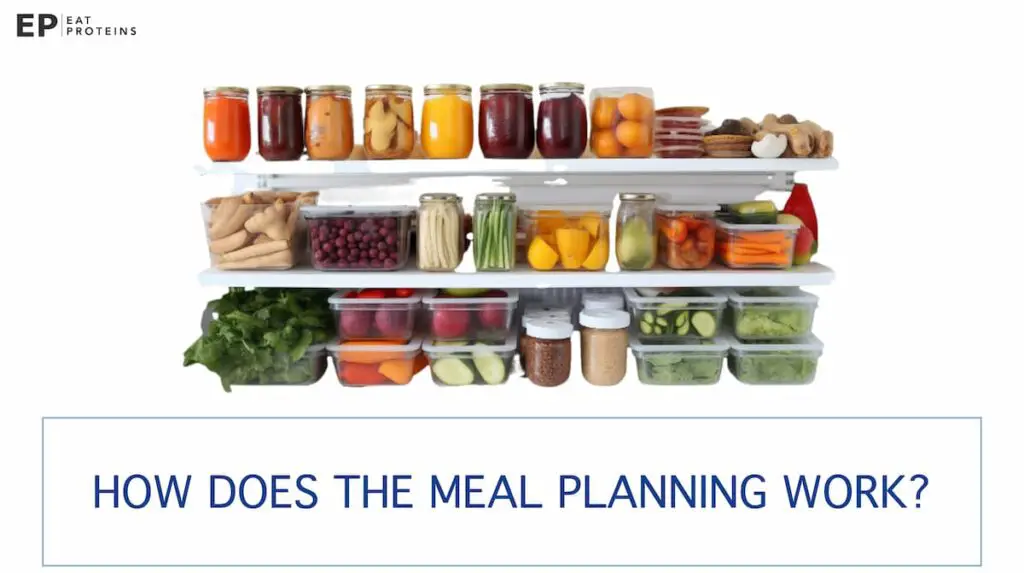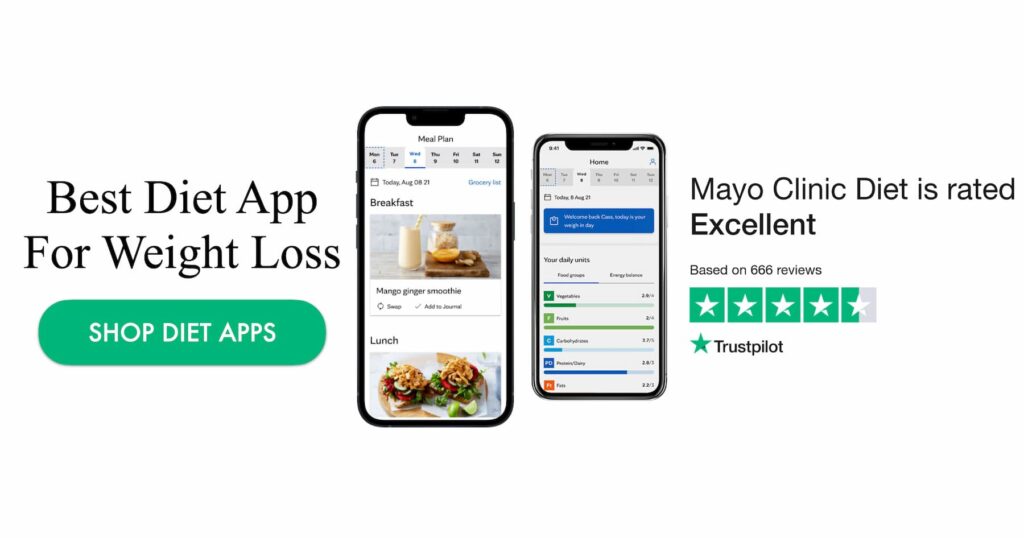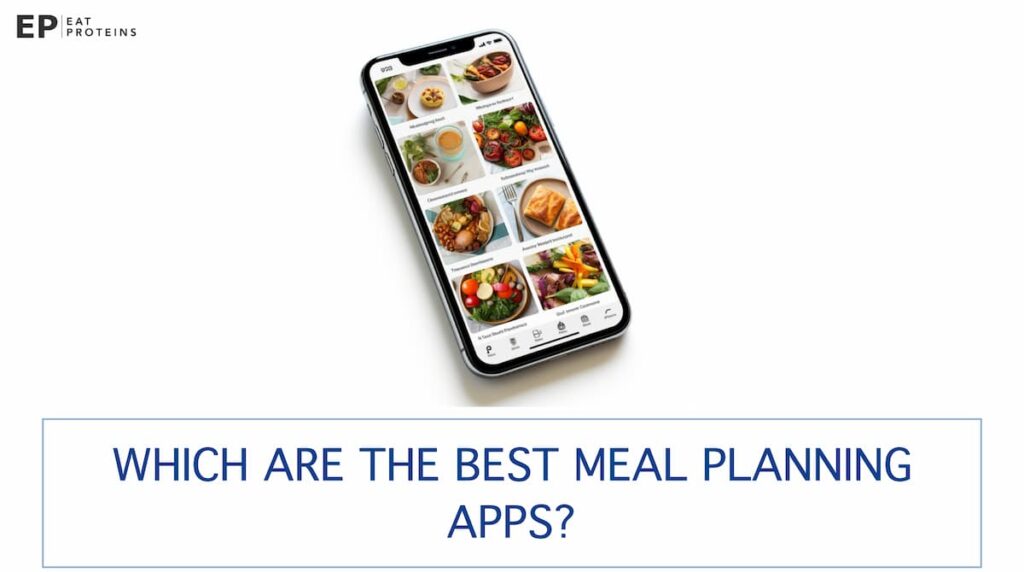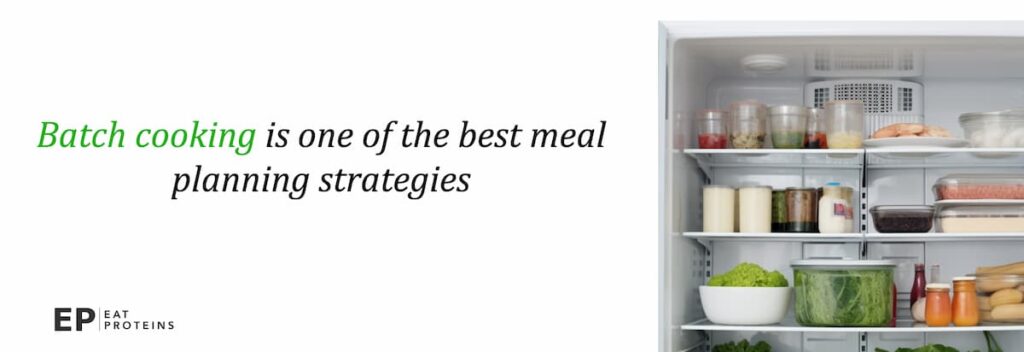Meal planning refers to the practice of organizing meals in advance, typically for a week or longer. It involves creating a plan for what to cook for dinner, selecting recipes, creating a grocery list, and prepping ingredients, which helps reduce decision fatigue and saves time.
Meal planning is important as it helps individuals maintain a healthy eating pattern and meet their nutritional needs. It also promotes portion control and can aid in weight management. The main benefit of meal planning is that it allows for better control over food choices, leading to a higher intake of fruits, vegetables, whole grains, and lean proteins. However, one main adverse effect of meal planning can be the potential for monotony or boredom with repetitive meals if not enough variety is incorporated.
EatProteins.com is a reader-supported platform. Purchases made through our links may earn us a commission at no extra cost to you.
What is meal planning?
Meal planning, also known as menu planning or meal prep, is the systematic approach of creating a weekly or monthly meal schedule that aligns with your nutritional requirements. This process involves carefully selecting recipes for breakfast, lunch, dinner, and snacks, creating a shopping list, purchasing the necessary ingredients, and preparing them in advance.
According to a study from Washington University School of Medicine and the University at Buffalo, frequent meal planning was directly associated with greater weight loss.
“We found that participants who engaged in higher average meal planning frequency lost more weight compared to those who didn’t,” says Jacqueline F Hayes, an Assistant Professor from Brown University.

“We had 139 participants in the study, and we monitored their meal and exercise planning frequencies at Weeks 0, 10, 20, 30, and 40. Interestingly, while exercise planning did increase over the course of the study, it wasn’t as closely linked to weight loss outcomes as meal planning was,” Jacqueline adds. This suggests that meal planning should be a continuous focus in weight loss programs to achieve better results.
Meal planning is a valuable tool for individuals seeking to achieve specific health goals, manage chronic conditions, or adhere to dietary restrictions. It allows for careful consideration of portion sizes, macronutrient distribution, and overall calorie intake.
Moreover, meal planning provides an opportunity for experimentation and customization, such as incorporating takeout nights or repurposing leftovers creatively. By proactively planning meals, you can also reduce stress and decision fatigue associated with daily mealtime dilemmas.
How does the meal planning work?
Meal planning works by helping individuals make better food choices, especially when they’re highly conscious of their health, according to a study conducted by the Universidade Federal de Santa Catarina in Brazil and Queen’s University Belfast in the UK.

“We found that High Health Conscious (HHC) participants planned healthier meals compared to Low Health Conscious (LHC) individuals during a simulated shopping task,” says Anice M de Camargo, a researcher at Universidade Federal de Santa Catarina.
The HHC group chose more whole grains, fruits, and vegetables. They were influenced not just by health-related motives, but also by the characteristics of the ingredients and their cooking habits.
“On the other hand, LHC participants focused mainly on their own preferences and admitted they lacked the skills needed for meal preparation.” She adds, “Our study, published in January 2020, suggests that being health-conscious and knowing how to cook are closely linked and deserve more attention in future research.”
In other words, meal planning is a proactive approach. Meal planning provides structure and efficiency to your eating habits. Preparing meals in advance, such as chopping vegetables or cooking grains, saves time during busy weekdays and reduces the temptation to rely on fast food or unhealthy convenience options.
What are the benefits of meal planning?
Meal planning offers a multitude of benefits that can significantly impact your life, both in terms of health and convenience, as shown in a 2018 study conducted at the Mayo Clinic in Rochester.
“Meal planning helped participants reduce perceived barriers to healthy eating and improved their dietary intake,” says Katherine A. Zeratsky, a dietitian at the Mayo Clinic’s Dan Abraham Healthy Living Center.
Here are 7 benefits of meal planning.
- Time savings: Meal planning can save up to 2 hours per week by reducing the time spent on daily meal preparation and decision-making.
- Money savings: By planning meals, individuals can save up to $50 per week by reducing food waste and avoiding impulse purchases.
- Healthier food choices: Meal planning promotes healthier eating patterns, resulting in a 15% increase in consumption of fruits and vegetables.
- Portion control: With meal planning, individuals can better manage portion sizes, leading to an average reduction of 200-300 calories per meal.
- Weight management: Meal planning has been shown to support weight loss efforts, with individuals losing an average of 1-2 pounds per week.
- Improved nutrition: By following a meal plan, individuals consume more essential nutrients, such as fiber, vitamins, and minerals.
- Reduced stress: Having a meal plan in place reduces stress by providing a clear roadmap for the week and eliminating the need for daily meal decisions.
What are the drawbacks of meal planning?
Meal planning has several drawbacks that should be considered.
- Time investment: Meal planning requires an initial time investment to research recipes, create a meal plan, and make a grocery list, which can be time-consuming for beginners.
- Restrictive nature: Sticking to a meal plan can feel restrictive and limit the ability to try new foods or dine out with friends and family.
- Lack of spontaneity: Meal planning may limit the ability to have spontaneous meals or try new recipes on a whim.
- Monotony: Consistent meal prepping and cooking can become monotonous and tedious over time.
- Burnout: The meal planning process can lead to burnout if not approached with a balance and flexibility that works for the individual.
- Limited variety: Following a meal plan may result in a limited variety of foods and nutrients if not carefully planned.
- Waste: In some cases, meal planning may lead to food waste if ingredients are not used before they spoil.
What are some meal planning strategies for weight loss?
For effective weight loss, one of the latest strategies is using AI-powered meal planners that can customize meal plans based on individual dietary needs, activity levels, and health goals.

“Personalized meal planning that considers your specific health conditions, personal preferences, and status can be more effective for weight loss,” says Maryam Amiri, a researcher from the Department of Computer Science at North Dakota State University.
She elaborates, “Our study showed that an AI-powered meal planner could generate meal plans optimized for the user’s health concerns and nutritional needs. We used methods like semantic reasoning, fuzzy logic, and heuristic search to create these personalized plans,” says Maryam.
So, instead of just counting calories, the system takes into account various factors such as existing health conditions, nutritional requirements, and even food restrictions due to allergies or religious beliefs.
According to Dr. Amiri, “The results of AI meal planning were promising; users were generally satisfied with the personalized meal plans that the system generated.”
Traditional methods like portion control, meal prepping, and focusing on nutrient-dense foods continue to be effective for weight management.
Some of the more traditional meal-planning strategies for weight loss include the following.
- Prioritizing healthy meal planning: Incorporating a variety of fruits, vegetables, lean proteins, and whole grains into your meal plan can support weight loss by providing essential nutrients and fiber while avoiding overly processed foods, sugary snacks, and high-calorie beverages.
- Practicing portion control: Studies indicate that paying attention to portion sizes and using measuring cups and a kitchen scale to ensure accurate serving sizes can help manage calorie intake and facilitate weight loss goals.
- Including protein-rich foods: Research suggests that consuming adequate protein, approximately 0.8-1 gram per kilogram of body weight, can promote satiety, preserve muscle mass, and support weight loss efforts.
- Incorporating fiber: Evidence shows that consuming high-fiber foods, such as fruits, vegetables, and whole grains, can aid in weight loss by promoting feelings of fullness and reducing calorie intake.
- Planning balanced meals: Studies indicate that creating balanced meals that include a mix of carbohydrates, proteins, and healthy fats can help regulate appetite, stabilize blood sugar levels, and support weight loss.
- Preparing meals in advance: Research suggests that meal prepping and preparing meals in advance can promote healthier food choices, reduce impulse eating, and support portion control for weight loss.
- Utilizing a meal planning app: Research shows that using a meal planning app can aid in weight loss by providing recipe suggestions, grocery lists, and nutrition tracking, making it easier to stay organized and plan meals effectively.
What are the features of a good meal planning app?
A good meal planning app should have user-friendly features and offer frequent updates. It should provide a variety of features, including a meal planning calendar to schedule meals ahead and ensure you have all the necessary ingredients.

Additionally, it should offer a meal planning template or ideas for inspiration and variety, have a user-friendly interface, and receive frequent updates to stay functional and up-to-date.
Features of a good meal planning app include the following.
- Google Sheets Integration: Allows users to export and import meal plans, shopping lists, and nutritional information directly to and from Google Sheets.
- BMR Calculator: Integrated Basal Metabolic Rate (BMR) calculator to tailor calorie needs based on individual metabolic rates.
- Excel Compatibility: Enables data exchange with Microsoft Excel for more advanced analytics or sharing options.
- User-Friendly Interface: Easy-to-use design that facilitates quick meal planning and modifications.
- Recipe Database: Features a comprehensive database of healthy recipes, sortable by dietary restrictions, cuisine, and meal type.
- Grocery List Generator: Automatically creates a shopping list based on the meal plan selected.
- Nutritional Tracking: Provides detailed nutritional information for each meal, including macronutrients and micronutrients.
- Meal Customization: Allows users to swap out meals or ingredients to suit personal preferences or dietary restrictions.
- Progress Tracking: Tracks weight loss and fitness metrics over time, offering insights and recommendations for adjustments.
How to use Google Sheets for meal planning?
Google Sheets is a convenient and versatile tool for meal planning, offering various features to simplify the process. Here’s how to use Google Sheets for meal planning.
- Access Google Sheets from any device with an internet connection.
- Create a customized meal planning template using Google Sheets.
- Organize your meal plan by creating different tabs for each day of the week or separate tabs for breakfast, lunch, and dinner.
- Utilize formulas and functions in Google Sheets to calculate nutritional information for your meals.
- Create shopping lists directly in Google Sheets to easily keep track of the ingredients you need.
- Use Google Sheets to track your budget by inputting the cost of ingredients and calculating total expenses.
- Collaborate with others by sharing your meal planning worksheet, making it easy to coordinate meals with family or roommates.
- Take advantage of the mobile accessibility of Google Sheets for on-the-go meal planning.
- Consider using Google Sheets’ features in combination with other meal planning resources, such as printable meal planning worksheets or Excel templates, to further enhance your meal planning experience.
How to use a BMR calculator for meal planning?
To use a BMR calculator for meal planning, follow these instructions:
- Input your age, gender, weight, and height into the BMR calculator.
- Select the activity level that best represents your daily physical activity.
- The BMR calculator will provide you with an estimate of your Basal Metabolic Rate (BMR), which is the number of calories your body needs to maintain basic bodily functions at rest.
- Use this BMR value to determine the appropriate caloric intake for your goals, whether it’s weight loss, maintenance, or muscle gain.
- Create a well-balanced meal plan that aligns with your goals by considering the calories provided by the BMR calculator.
- Ensure that your meal plan includes all the necessary macronutrients (carbohydrates, proteins, and fats) in appropriate proportions.
- Consider the quality of the food you consume, focusing on nutrient-dense options that provide essential vitamins and minerals.
- Monitor your progress and make adjustments to your meal plan as needed based on your body’s response and goal achievement.
- Consult with a registered dietitian or nutritionist for personalized advice and guidance.
How to use Excel for meal planning?
Excel can be used for meal planning by creating a customizable spreadsheet that allows you to input meal ideas, ingredients, and cooking instructions. Pre-made meal planning templates in Excel can also be utilized, which include sections for breakfast, lunch, dinner, and snacks, as well as a grocery list.
- Create a meal planning spreadsheet in Excel.
- Customize the spreadsheet to include columns for meal ideas, ingredients, and cooking instructions.
- Input your desired meal ideas, along with their corresponding ingredients and cooking instructions.
- Utilize pre-made meal planning templates in Excel.
- Look for templates that cater to your dietary preferences and budget.
- Fill in the template with your meal ideas for breakfast, lunch, dinner, and snacks.
- Use the grocery list section of the template to create a comprehensive list of ingredients needed for your planned meals.
- Review and revise your meal plan and grocery list as needed.
- Use the meal planning spreadsheet or template as a reference and guide for your meal preparation and grocery shopping.
Which are the best meal planning apps?
The best meal planning apps based on user reviews and features include the following.

- Paprika: A highly recommended meal planning app that offers flexibility and customization options, allowing users to create grocery lists for easier shopping.
- Mealime: Ideal for those with limited time, Mealime generates recipes and shopping lists quickly to streamline the meal planning process.
- PlateJoy: For individuals aiming to lose weight, PlateJoy provides personalized meal plans and grocery lists tailored to specific goals.
- Eat This Much: Offering custom meal plans and calorie tracking, Eat This Much helps users meet their nutritional needs while keeping track of their calorie intake.
- Plan to Eat: Known for its user-friendly interface, Plan to Eat allows users to import recipes, create meal plans, and generate shopping lists effortlessly.
- Yummly: With a vast collection of recipes and personalized recommendations, Yummly is a popular choice for finding new meal ideas and planning menus.
- BigOven: Featuring over 350,000 recipes and the ability to create grocery lists, BigOven is a comprehensive meal planning app suitable for individuals and families.
How to do meal planning?
To start meal planning, follow the steps below.
- Assess your dietary needs and preferences, considering any dietary restrictions or allergies.
- Plan meals for the week, including breakfast, lunch, dinner, and snacks, aiming for a balance of protein, carbohydrates, and healthy fats in each meal.
- Create a shopping list based on your meal plan to ensure you have all the necessary ingredients.
- Prioritize fresh, whole foods and include a variety of fruits, vegetables, lean proteins, whole grains, and healthy fats.
- Prepare and cook meals in advance, such as batch cooking or prepping ingredients, to save time during busy days.
- Store meals in portion-sized containers to make it easy to grab and go, promoting portion control and reducing the risk of overeating.
- Consider using meal planning apps or templates to streamline the process and stay organized.
- Take advantage of leftovers by incorporating them into future meals or repurposing them for new dishes.
- Regularly review and adjust your meal plan to accommodate changes in schedule, preferences, or nutritional goals.
How to do meal planning on a budget?
To do meal planning on a budget, follow these 9 steps.
- Plan your meals for the entire week in advance to stay organized and avoid last-minute, costly food purchases.
- Look for sales and discounts at your local grocery store to save money.
- Consider buying in bulk to save even more.
- Prioritize cost-effective ingredients like beans, lentils, rice, and seasonal produce.
- These ingredients are not only budget-friendly but also versatile and nutritious.
- Meal prep to avoid food waste and ensure you can enjoy your meals throughout the week without additional costs.
- Stretch your budget further by incorporating leftovers into future meals.
- Opt for homemade meals instead of eating out to save money.
- Use online resources and apps to find budget-friendly recipes and meal planning ideas.
What are some popular meal planning recipes?
Some popular meal planning recipes include the following.
- Strawberry Peach Overnight Oats: Combine 1/2 cup rolled oats, 1 cup almond milk, 1/4 cup Greek yogurt, 1 tablespoon chia seeds, 1/2 cup fresh strawberries, and 1/2 cup peaches in a jar. Let it sit in the refrigerator overnight for a nutritious and filling breakfast.
- Thai Chicken Lunch Bowls: Marinate 4 ounces of chicken breast in a mixture of 2 tablespoons soy sauce, 1 tablespoon lime juice, 1 teaspoon ginger, and 1 teaspoon garlic. Grill the chicken and serve it with 1/2 cup brown rice, colorful veggies, and homemade peanut sauce for a flavorful and satisfying lunch.
- Easy Vegan Red Lentil Dal: Cook 1 cup of red lentils with 2 cups of diced tomatoes, 1 cup of chopped onions, and a blend of spices including turmeric, cumin, and coriander. Serve with 1 cup basmati rice or naan bread for a protein-rich vegetarian meal.
- Greek Salad: Toss together 2 cups chopped romaine lettuce, 1 cup diced cucumbers, 1 cup cherry tomatoes, 1/2 cup sliced red onions, 1/4 cup sliced Kalamata olives, and 1/4 cup crumbled feta cheese. Drizzle with olive oil and lemon juice for a refreshing and healthy salad.
What are some tips for planning meals for the week?
Meal planning for the week is an effective strategy for ensuring a balanced and nutritious diet. Here are some tips to help you plan your meals for 7 days:
- Include your family’s favorite meals in your meal planning to increase adherence and excitement.
- Consider any dietary restrictions or health goals, such as low sodium for those with hypertension.
- Focus on using herbs and spices to add flavor instead of salt, aiming for less than 2,300 mg of sodium per day.
- If you are planning meals for one, make larger portions and save leftovers for future meals.
- Incorporate healthy options for diabetics or those aiming to lose weight by including a variety of fruits, vegetables, lean proteins, and whole grains.
- Aim for at least 5 servings of fruits and vegetables per day to meet recommended nutrient intake.
- Include lean proteins such as chicken, fish, tofu, or legumes to provide essential amino acids for muscle growth and repair.
Note: It is important to consult with a healthcare professional or registered dietitian for personalized advice based on your specific dietary needs and goals.
What are some meal planning tips for a single person?
Meal planning for a single person can be optimized by incorporating versatility and portion control.
“Meal planning for a single person can be much more efficient when individual food preferences are considered alongside nutritional guidelines,” says Jen-Hao Hsiao, a researcher affiliated with IBM Research Collaboratory in Taiwan.
Hsiao explains, “Our 2013 study focused on creating personalized dietary guidelines that are not only nutrient-balanced but also aligned with an individual’s food preferences. We employed a technique called k-relative learning to semi-automatically extract users’ food preferences. This method allows us to gather data more efficiently and provide a meal plan that the user is more likely to follow.”

Hsiao says, “By integrating personal preferences into meal planning, we aim to increase compliance with healthier lifestyles. After all, people are more likely to stick to a diet plan that includes foods they actually enjoy.”
Here are 7 tips to make meal planning easier and more efficient.
- Scale down recipes to one or two servings to avoid leftovers and waste.
- Utilize freezer-friendly meals by preparing larger batches and freezing individual portions.
- Plan meals that use common ingredients to minimize food waste and save money.
- Embrace leftovers and repurpose them into new meals for added variety.
- Prioritize nutrient-dense foods to meet nutritional needs without overeating.
- Include a variety of food groups to ensure a balanced and diverse diet.
- Consider using technology or apps to help with meal planning and grocery shopping.
What are some easy meal planning strategies for beginners?
“Starting with small, manageable changes like increasing plant-based meals by one each week can make meal planning easier for beginners,” says Laura Klein, MBA, of the CHEF Coaching Program at Spaulding Rehabilitation Hospital, affiliated with Harvard Medical School.
Klein explains, “Batch cooking is one of the best meal planning strategies. It allows you to prepare food ahead of time in large quantities to be used in various meals throughout the week. For instance, beans and legumes can be cooked in advance and added to multiple dishes like soups, stews, and salads.”

She further advises, “Whole grains like quinoa, barley, and brown rice are also great for meal planning batch cooking. Once cooked, they can be stored in the fridge and repurposed in hot cereals, salads, or side dishes.”
Kimberly Parks, DO, FACC, from the Division of Cardiology at Massachusetts General Hospital, also affiliated with Harvard Medical School, adds, “Consider using a method like ‘Meatless Monday’ to slowly integrate more plant-based foods into your diet. It’s a global movement aimed at reducing meat consumption by 15% for both personal and environmental health.”
Parks also emphasizes, “Always think about storage. Use serving-sized containers to prepackage your meals, which not only makes it convenient but also helps with portion control. This approach, rooted in our study published in 2020, can pave the way for a more structured and effective meal planning routine for beginners.”
What are some meal planning ideas for families?
Parks suggests, “One idea is to involve the whole family in meal planning. Let each family member pick a dish they want for the week. This ensures everyone’s preferences are considered and also makes the meal planning more interactive and fun.”
Involve your kids in the meal prep process. Not only does this teach them valuable kitchen skills, but it also instills healthy eating habits from a young age. And don’t forget the power of batch cooking—prepare large portions of meals and freeze them. It’s a time-saver and also allows for easy customization of meals with different toppings.
Parks continues, “We advocate for a rotating system where each family member takes turns choosing a meal for the week. It’s a democratic way to ensure everyone’s tastes are considered, and it adds an element of surprise to mealtime.”
Klein also recommends, “Use theme nights to simplify planning. For example, designate Monday as ‘Pasta Night,’ Tuesday as ‘Taco Night,’ and so on. It narrows down the choices and makes planning less overwhelming.”
Other examples of meal planning ideas for families include the following.
- Customizable toppings: Allow each family member to personalize their meals with toppings or ingredients of their choice.
- Meal prep: Involve children in meal preparation to develop healthy eating habits and kitchen skills.
- Plan leftovers: Incorporate leftovers into meal plans to reduce food waste.
- Online resources: Utilize meal planning websites or apps that provide recipes and grocery lists for easy planning.
What are some tips for vacation meal planning?
Vacation meal planning involves packing a cooler and preparing simple meals that can be easily enjoyed during your trip.
“Spending more time on meal preparation is linked to better mental health and reduced stress, but it also makes people feel like they have less time,” says Michael J. Widener, a researcher from the Department of Geography and Planning at the University of Toronto.
Widener elaborates, “When it comes to vacation meal planning, it’s important to strike a balance between nutritious meals and convenience to avoid the stress of time scarcity. One tip we often suggest is to do meal prep before your vacation. Preparing large quantities of meals and freezing them can relieve a lot of pressure during the vacation.”
Here are 7 tips to make your vacation meal planning a success.
- Research local grocery stores or farmer’s markets near your vacation spot to stock up on fresh ingredients.
- Choose meals that require minimal cooking and can be easily prepared with limited kitchen equipment.
- Consider using a meal planning app with a grocery list feature to stay organized and ensure you have all the ingredients you need.
- Opt for nutrient-dense foods, such as fruits, vegetables, lean proteins, and whole grains, to support your health goals.
- Pack snacks like nuts, seeds, or granola bars to have on hand for quick and convenient options.
- Plan for hydration by packing reusable water bottles and considering low-calorie beverages like unsweetened tea or infused water.
- Allow for flexibility and enjoyment by incorporating local cuisine or dining out for a few meals while still maintaining a balanced approach to your vacation eating.
Smith continues, “It’s crucial to plan for flexibility. You’re on vacation, after all. Have a couple of backup meal options that are easy to prepare in case plans change. Our research shows that better planning can positively impact mental health and overall well-being, even on vacation,” says Smith.
What are some meal planning tips for someone on an low carb diet?
For those committed to the low carb diet, meal planning is crucial. “One of the first tips is to focus on high-protein, high-fat foods such as meats, cheeses, and certain vegetables while strictly limiting carbohydrates to under 30g a day,” says Arne Astrup, a researcher from the Department of Human Nutrition at RVA University in Copenhagen.
Prepare portions of allowable proteins and fats at the beginning of the week. This not only saves time but also helps you avoid last-minute, less-healthy choices.
“Another tip is to incorporate variety within the low carb diet’s restrictions to prevent boredom. For instance, alternate between different types of protein sources like chicken, beef, and fish,” Astrup says.
How to create a meal planning calendar template?
To create a meal planning calendar template, you can use a digital calendar app and a printable template. This will help you stay organized and plan your meals throughout the week. Here are 9 ways for creating a meal planning calendar template.
- Use a combination of a digital calendar app and a printable template.
- Start with a 3 column and 3 row table to represent each day of the week.
- Label the columns as “Day,” “Breakfast,” and “Lunch.”
- Fill in the table with specific meal options for each day.
- Consider incorporating a variety of healthy options into your meals.
- Experiment with different recipes and meal combinations to keep things interesting.
- Take into account your dietary needs and preferences when planning your meals.
- Use the meal planning calendar template to visualize and plan your meals in advance.
- Refer to the template throughout the week to stay on track with your meal plan.
Where can one find meal planning PDFs?
Meal planning PDFs can be found on various websites and online resources. These PDFs offer structured frameworks for effective meal planning and organization. Meal planning websites often provide free downloadable PDFs in the form of meal planning sheets or worksheets. Joining online communities focused on meal planning can also give access to PDFs shared by experienced meal planners.
